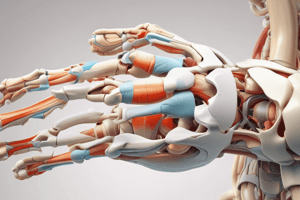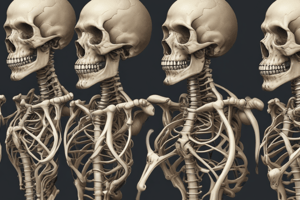Podcast
Questions and Answers
What is the study of joints called?
What is the study of joints called?
Arthrology
What are joints?
What are joints?
- Flexible connections between bones
- Solid connections without movement
- Unions of muscle and bone
- Junctions between bones (correct)
What does joint classification refer to?
What does joint classification refer to?
Structural classification based on connectivity and motility
What type of joint is freely movable and contains a cavity filled with synovial fluid?
What type of joint is freely movable and contains a cavity filled with synovial fluid?
What joint type is characterized by cartilage connecting two bones?
What joint type is characterized by cartilage connecting two bones?
Define a freely movable joint.
Define a freely movable joint.
How are immovable joints held together?
How are immovable joints held together?
What is a slightly movable joint classified as?
What is a slightly movable joint classified as?
Which of the following is NOT a biomechanical classification of joints?
Which of the following is NOT a biomechanical classification of joints?
What does a simple joint have?
What does a simple joint have?
What defines a complex joint?
What defines a complex joint?
Define a compound joint.
Define a compound joint.
What are fibrous joints connected by?
What are fibrous joints connected by?
What type of fibrous joint is seen in skull bones?
What type of fibrous joint is seen in skull bones?
What does syndesmosis refer to?
What does syndesmosis refer to?
What is a gomphosis?
What is a gomphosis?
What type of joint allows for slight movements due to being joined by fibrocartilage?
What type of joint allows for slight movements due to being joined by fibrocartilage?
What is the function of synchondrosis?
What is the function of synchondrosis?
What do all synovial joints have?
What do all synovial joints have?
What is the outer layer of the joint capsule called?
What is the outer layer of the joint capsule called?
What is a bursa?
What is a bursa?
What is a synovial sheath?
What is a synovial sheath?
What is synovial fluid?
What is synovial fluid?
What connects bone to bone?
What connects bone to bone?
What are the ligaments of the stifle joint?
What are the ligaments of the stifle joint?
What are the components of the cruciate ligament?
What are the components of the cruciate ligament?
Define intracapsular.
Define intracapsular.
Define extracapsular.
Define extracapsular.
What does nociception refer to?
What does nociception refer to?
What does proprioception maintain?
What does proprioception maintain?
What is a meniscus and its function?
What is a meniscus and its function?
What is a labrum?
What is a labrum?
What are the types of joint movement?
What are the types of joint movement?
What defines translation in joint movement?
What defines translation in joint movement?
What does rotation refer to?
What does rotation refer to?
What does swing refer to in joint movement?
What does swing refer to in joint movement?
Flashcards are hidden until you start studying
Study Notes
General Concepts of Arthrology
- Arthrology is the study of joints and their functions.
- Joints are junctions between bones; some are movable while others are not.
Joint Classification
- Joints can be classified structurally based on how they are connected and their degree of mobility.
- Three main types of joints:
- Synovial Joints: Freely movable joints containing a synovial fluid-filled cavity (e.g., stifle and elbow).
- Cartilaginous Joints: Connect bones via cartilage, allowing slight movement but providing stability (e.g., pubic symphysis).
- Fibrous Joints: Held together by fibrous connective tissue, usually immovable (e.g., sutures in the skull).
Types of Joints by Mobility
- Diarthrosis: Freely movable joint, synonymous with synovial joint.
- Synarthrosis: Immovable joint where bones are fused, often found in the skull.
- Amphiarthrosis: Slightly movable joints, primarily cartilaginous in nature.
Biomechanical Joint Classifications
- Simple Joint: Consists of two articulating surfaces.
- Complex Joint: Contains two or more surfaces with an articular disk or meniscus (e.g., knee).
- Compound Joint: Involves three or more articulating surfaces.
Specific Joint Types
- Sutures: Fibrous joints located in skull bones.
- Syndesmosis: Connects bones with interosseous ligaments, exemplified by the radius and ulna in carnivores.
- Gomphosis: Non-true joints where teeth are implanted into jawbone.
- Symphysis: Joints where bones connect via fibrocartilage.
- Synchondrosis: Cartilaginous joints responsible for growth, uniting diaphysis and epiphysis in bones.
Synovial Joint Characteristics
- All synovial joints feature articular surfaces on bones, articular cartilage covering those surfaces, and fluid-filled joint cavities enclosed by joint capsules.
- Joint Capsule: Comprises an outer fibrous layer and an inner synovial membrane that produces synovial fluid.
- Bursa: Sac-like structures that reduce friction between tissues, located between skin/bones, tendons/bones, and ligaments/bones.
- Synovial Sheath: A bursa that fully wraps around tendons.
Joint Components and Stability
- Synovial Fluid: Transparent, lubricating substance similar to egg whites, crucial for joint mobility.
- Ligaments: Connective tissue that links bones, providing stability.
- Intracapsular Ligaments: Positioned within the joint capsule (e.g., cruciate ligaments of the stifle).
- Extracapsular Ligaments: Located outside of the joint capsule (e.g., collateral ligaments of hinge joints).
Sensory Functions in Ligaments
- Nociception: Pain receptors found in all ligaments, alerting to injury or stress.
- Proprioception: Stretch receptors in ligaments, ensuring the central nervous system receives feedback about joint positions and tension.
Joint Features and Movements
- Meniscus: Divides the joint cavity, composed of hyaline cartilage and fibrous tissue, providing shock absorption and enhancing motion (e.g., stifle joint).
- Labrum: Fibrocartilaginous rim that deepens the joint socket.
- Joint movements encompass various actions, including:
- Translation: Movement changing position without rotation.
- Rotation: Turning around an axis.
- Swing: Movement through an arc.
Studying That Suits You
Use AI to generate personalized quizzes and flashcards to suit your learning preferences.




